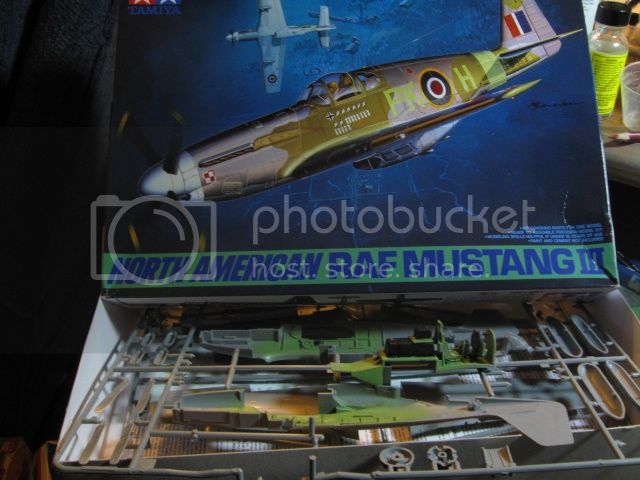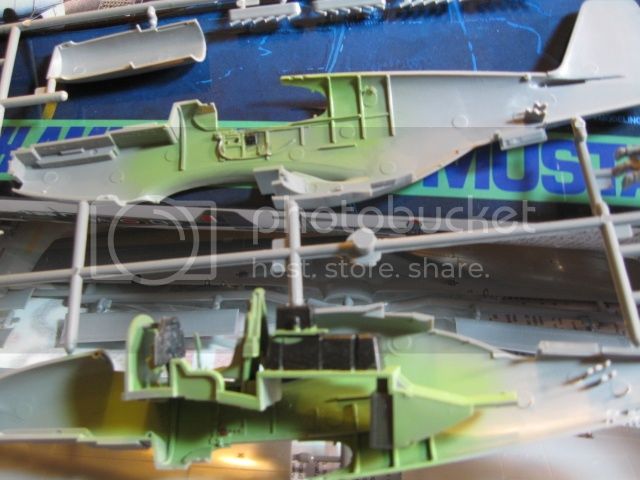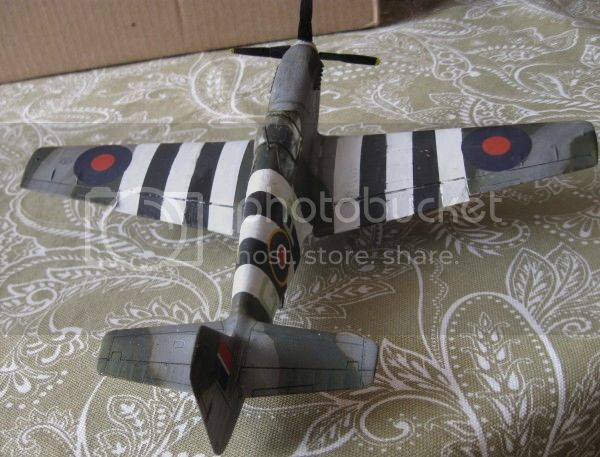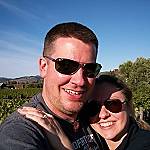Paints: Tamiya acrylics for base; stripes and interior Golden Fluid Acrylics
Weathering: Iwata Com.Art acrylics



I did this for the D-Day Group Build over on Finescale. This was my first late 90s vintage Tamiya kit so I don't have many build pics because the plane more or less built itself. There was a nasty seam on the bottom but I'd say that was simply a bad mold or bad luck. Overall the fit was terrific – I do like it when landing gear cause no problems. I did end up a little befuddled about the antenna. After looking at the kit and a whole lot of photos online it appears that many P-51Bs carrying the “Malcom Hood” didn't have an antenna at all, but some did. (Many photos show a very small and very thin antenna with a pronounced bend.) I stared at a lot of photos and examples of very good models and I found almost no sign of a wire leading back to the tail so I left it off. Unfortunately the kit had poor decals. They were rugged enough but the “sky” colored letters just don't look right.
In the spirit of D-Day, I wanted to tip my hat to one of the smaller allies that helped greatly in the formidable task of turning Hitler's Reich into rubble. In this case we have a P-51 MKIII flown by the crack RAF 315 Squadron made up of Polish pilots. It says something that of the very small allotment of P-51Bs to the RAF, that two Polish squadrons were so equipped. They arrived early in 1944 and spent several months in the very nasty air war the RAF ran against German shipping and air bases in Norway, a task well suited to the P-51s “long legs.” But when D-Day came, more or less everything that could fly was delegated to direct support of the landings. People think of Jugs or Typhoons when they think of allied Jabo, and for good reason. However, the P-51, water cooled engine and all, was an excellent ground attack aircraft because of its ability to take care of unwanted problems. It was also, like all US planes, very rugged. Although elite fighter groups of 8th AF made their reputation destroying the Luftwaffe in combat, Mustangs were widely used with great effect for ground attack – after all, if you weren't flying to Berlin all that weight going to fuel tanks could go to bombs and rockets. (Both the P-51 and Corsair were widely used for ground attack during Korea when their day as premier fighters was over.)
Not for the first time, I did get dragged into a color quandary. I did as much research as I could online and was also helped by aviation author and color guru Nick Millman. Here's the situation as I understand it. RAF mustangs were painted at US factories using the “nearest possible” US equivalent of RAF paints. First there was the interior. Several paint manufacturers produced US “interior green” but a batch made by DuPont was used for the RAF because it was a close match to the Brit rendition. I found a color sample of it and made up a pretty decent match using Vallejo Model Colors.

The plane itself got two shades of gray and olive drab. Apparently some of the 51s were wholly or partially repainted when they arrived in the UK. According to Millman, it was very likely that a RAF Mustang might get a new paint of one or both of the grays, but might well keep the OD. The P51 Bs were some of the very few planes that got the 1943 rendition of OD which is distinctly lighter than the 1940 version employed on almost all US combat planes. It's also more green. Nick sent me color samples of both and they do look quite alike.
I used Tamiya paints for the first time in months and can see why so many good modelers chose the brand. The 315 Squadron P51s fought a major campaign prior to D-Day, and I weathered it fairly heavily with Iwata Com.Art acrylics which I find ideal for this kind of work. (The green tint given the OD made it look very like the RAF Green.)
But of course we wanted stripes. This called for a odd contrast. I failed to take pics of the pre-stripe plane, and the stripes absolutely dominate the kit visually. As you can see below, stripes dominate the look of a US 51B.

Applying the stripes was done at the very last minute for security reasons, and thus on June 4th there were ground crew all over the UK furiously slopping on black and white paints of whatever was available. (One RAF pilot described the stuff as “glop, but not really paint.”) Here's a pic of a Spitfire getting prepped:

I masked the wings with tape, but hand painted it with Golden Fluid carbon black and titanium white. For my money these are the two most opaque paints on the planet in their respective colors and show the exceptional quality of Golden pigments. With a little Flow Aid, Golden hand paints as well or better than Vallejo Model Color or Citadel. I used a pretty small brush which took some time, but I didn't want the brush strokes to be too large. There was a little over-paint which I fixed by hand to given the stripes the kind of irregular surface seen on the real articles.

That's about it: more pics below taken with my ancient Canon Sure Shot which lives in St. Paul.
Eric






















